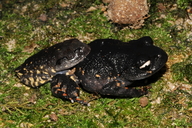|
Leptobrachium leucops Stuart, Rowley, Tran, Le & Hoang, 2011
White-eyed Spadefoot Toad, Yin-Yang Toad | family: Megophryidae subfamily: Leptobrachiinae genus: Leptobrachium |
| Species Description: Stuart BL, Rowley JJL, Tran DTA, Le DTT, Hoang HD 2011 The Leptobrachium (Anura: Megophryidae) of the Langbian Plateau, southern Vietnam, with description of a new species. Zootaxa 2804: 25-40. | |
 © 2019 Thanh Luan Nguyen (1 of 4) |
|
|
|
Description Diagnosis: Leptobrachium leucops is differentiated from the other species in the same genus and geographic range by the upper part of its iris being white. Another species in the area, L. pullum, have scarlet on the upper part of the iris. Leptobrachium pullum also has a white venter that is much lighter than the dorsum. In comparison, L. leucops have large dark markings on the dorsum and a dark venter. Both species are similar in size as adults. The call of the L. leucops is also structurally different from the L. pullum with multiple notes per call in comparison to the single note call of the L. pullum (Stuart et al. 2011). However, the call of the L. leucops overlaps with that of the L. masatakasatoi and L. pullum in both spectral and temporal properties. All three frogs have calls of a single pulsed note with a frequency around 1.0kHz (Pham et al. 2016). Coloration: The coloration in life of L. leucops consists of a dark gray dorsum that has a distinct, dark brown “Y”-shaped mark from its upper eyelids to its lower back. On the lower back and upper flank there are small irregular marks of brown to black coloring edged with cream. The lower flank is dark gray with minute white spots. The upper surface of the forelimb has dark grey bands with narrower cream bands alongside them. The upper surface of the hind limb is creamy white with dark gray and black bands. On the edge of the upper lip to the nostril there is a brown bar and from the edge of the upper lip to the lower part of the eye there is a black streak. On the ventral surface of the body, there is a purplish-gray to dark gray coloring that is minutely spotted with white. The coloration in preservative is similar to life with the exception that the cream on dorsal features fades to white or gray while the ventral surface fades to dark gray (Stuart et al. 2011). Variation: The dorsal pattern is highly variable in both size and shape. The background color of the dorsum varies from brown to gray and the ventral coloration can be dark gray to black in certain members of the species. Some members lack black spotting on the chin. For some members of the species the white of the upper iris extends to about half of the iris (Stuart et al. 2011). Distribution and Habitat Country distribution from AmphibiaWeb's database: Viet Nam
Life History, Abundance, Activity, and Special Behaviors The call of the L. leucops has multiple notes, which distinguishes it from other species of Leptobrachium. The call consists of an average of three to four highly pulsed notes that last 0.10 - 1.70 seconds. The notes are evenly distributed and contain eight to fifteen pulses repeated constantly throughout the call that sound like “a rapid barking ‘wah-wah-wah-wah.’” Males make their call from shallow burrows or under leaf-litter near streams. They also call at the same time as another species in the same habitat, L. pullum, and are heard calling within a few meters of each other during the spring (Stuart et al. 2011). A wide range of predators have been known to prey on this species, including snakes. As a result, L. leucops have developed defensive mechanisms, including crouching down, body contracting, body puffing-up, body-rising, and mouth gaping (Shahrudin 2016). No information was available on tadpoles of the L. leucops; however, a species from the same genus, L. lunatum, was found to produce tadpoles, which leads to the belief that L. leucops also produces tadpoles (Stuart et al. 2020). Trends and Threats Relation to Humans Possible reasons for amphibian decline General habitat alteration and loss Comments Phylogenetic Relationships Phylogenetic relationships among species in the Leptobrachium genus are still in flux as new species are being discovered yearly. However in a 2016 study by Yang et al., Bayesian Inference and Maximum Likelihood analyses of partial mitochondrial 16S rRNA gene sequences found that L. leucops sister to a clade that includes L. banae, L. buchardi, L. guangxiense, L. hainanense, L. mouhoti, L. ngoclinhense, L. pullum, L. xanthodpilum, and L. xanthops. Etymology The species epithet, “leucops” can be broken down into two greek words. The first being “leukos”, which translates to “white”, and the second being “ops,” which means “eye”. This species’ name is a reference to its distinguishable half white eye (Stuart et al. 2011).
References
IUCN SSC Amphibian Specialist Group. (2020). "Leptobrachium leucops (amended version of 2015 assessment)." The IUCN Red List of Threatened Species 2020: e.T46255743A176550123. https://dx.doi.org/10.2305/IUCN.UK.2020-3.RLTS.T46255743A176550123.en. Downloaded on 18 February 2021. Pham, A. V., Le, D. T., Pham, C. T., Nguyen, S. L. H., Ziegler, T., Nguyen, T. Q. (2016). “Two additional records of megophryid frogs, Leptobrachium masatakasatoi Matsui, 2013 and Leptolalax minimus (Taylor, 1962), for the herpetofauna of Vietnam.” Revue suisse de Zoologie 123(1), 35-43. [link] Shahrudin, S. (2016). “Antipredator behaviour of Leptobrachium hendricksoni Taylor, 1962, (Anura: Megophryidae) from Peninsular Malaysia.” Alytes 33,12-15. [link] Stuart, B. L., Rowley, J. J. L., Tran, D. T. A., Le, D. T. T., Hoang, H. D. (2011). “The Leptobrachium (Anura: Megophryidae) of the Langbian Plateau, southern Vietnam, with description of a new species.” Zootaxa 2804(1), 25–40. [link] Stuart, B. L., Som, H. E.,Neang, T., Hoang, H. D., Le, D. T. T., Dau, V. Q., Potter, K., Rowley, J. J. L. (2020) “Integrative taxonomic analysis reveals a new species of Leptobrachium (Anura: Megophryidae) from north-eastern Cambodia and central Vietnam.” Journal of Natural History 54(1-4), 225-255. [link] Yang, J., Wang, Y., Chan B. P. (2016). “A new species of the genus Leptobrachium (Anura: Megophryidae) from the Gaoligongshan Mountain Range, China.” Zootaxa 4150(2), 133-148. [link] Originally submitted by: Alexia Merritt, Jennifer Perez, Valeria Torres (2021-12-07) Description by: Alexia Merritt, Jennifer Perez, Valeria Torres (updated 2021-12-07)
Distribution by: Alexia Merritt, Jennifer Perez, Valeria Torres (updated 2021-12-07)
Life history by: Alexia Merritt, Jennifer Perez, Valeria Torres (updated 2021-12-07)
Trends and threats by: Alexia Merritt, Jennifer Perez, Valeria Torres (updated 2021-12-07)
Relation to humans by: Alexia Merritt, Jennifer Perez, Valeria Torres (updated 2021-12-07)
Comments by: Alexia Merritt, Jennifer Perez, Valeria Torres (updated 2021-12-07)
Edited by: Ann T. Chang (2021-12-07) Species Account Citation: AmphibiaWeb 2021 Leptobrachium leucops: White-eyed Spadefoot Toad <https://amphibiaweb.org/species/7953> University of California, Berkeley, CA, USA. Accessed May 6, 2025.
Feedback or comments about this page.
Citation: AmphibiaWeb. 2025. <https://amphibiaweb.org> University of California, Berkeley, CA, USA. Accessed 6 May 2025. AmphibiaWeb's policy on data use. |



 Map of Life
Map of Life